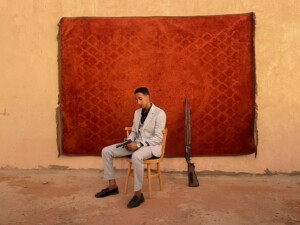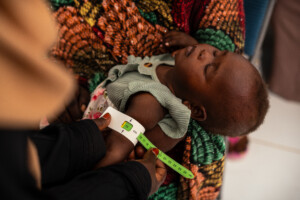Sudan OCHA bulletin 7: First convoy of Sudanese refugees from Chad
For the last 15 years, Adam El-Nour Abakar, 45 years old, was in exile in Chad. Last week, Adam and his family returned to their home in Kebkabiya village, in North Darfur with their five Children, all of whom were born in Chad.
 Sudanese refugee children arrive in Tina, North Darfur from Chad (April 2018, UNHCR)
Sudanese refugee children arrive in Tina, North Darfur from Chad (April 2018, UNHCR)
For the last 15 years, Adam El-Nour Abakar, 45 years old, was in exile in Chad. Last week, Adam and his family returned to their home in Kebkabiya village, in North Darfur with their five Children, all of whom were born in Chad.
In its latest biweekly bulletin, the UN Office for the Coordination of Humanitarian Affairs (OCHA) in Sudan quotes a returnee: “I’m so happy to return to my country with my family. I really feel comfortable and content. I cannot thank UNHCR and the Governments of Chad and Sudan enough for facilitating our return to Sudan,” said Abakar, with a deep sigh.
Adam and his family are part of a first convoy of 53 Sudanese refugees, who returned to Sudan from eastern Chad on 14 April, after more than a decade in exile. The UN Refugee Agency (UNHCR) and the Commissioner of Refugees (COR), Hamad El-Gizouli, welcomed the returning Sudanese refugees at the reception centre in Tina, North Darfur. Besides three months of food rations, the returnees were provided with a reintegration package and transportation of personal belongings and livestock to their home villages in North Darfur. The return follows the signing of a Tripartite Voluntary Repatriation Agreement in Khartoum on 31 May 2017, between the Governments of Sudan and Chad and UNHCR. Mr. El-Gizouli described the return as a historic moment. He reiterated the importance the Sudanese Government attaches to the voluntary return of refugees, and the hope that these returnees will be able to rebuild their lives as Sudanese citizens.
Sudan and Chad—with assistance from UNHCR and its partners—plan to repatriate 20,000 refugees from Chad this year. At least 300,000 Sudanese refugees are in Chad, many of whom fled Sudan following the conflicts in Darfur between 2003 and 2004. With the new stability and improved general security in Darfur, many have indicated an interest in returning, according to UNHCR.
With a shortfall of US$37.7 million to respond to recovery, returns and re-integration, Noriko Yoshida, UNHCR Representative for Sudan, appealed for urgent funding to assist the efforts of the Government of Sudan to provide durable solutions for returning communities.
Over 3,000 school children from Jebel Marra assisted to sit for basic education exams
Following recent inter-communal violence and localised conflicts in parts of Central and South Darfur states during early and mid-March 2018, authorities and humanitarian partners agreed to move the Grade 8 examination centres to Kass and Marshang localities in South Darfur State to ensure the safety of the students sitting for the examinations. This meant that the affected students had to travel about 100kms from their homes to the examination centres. Grade 8 examinations are a key prerequisite to receiving the Basic Education Certificate and an essential degree to transit to secondary school and for further education. For many children in the Darfur region–should they pass this exam–it is considered their highest educational attainment, if they are unable to access further education.
The UN Children’s Agency (UNICEF) and partners—in cooperation with the State Ministries of Education (SMoE) in Central and South Darfur states—supported 3,265 children from the Jebel Marra area with transportation to the new examination centres; essential school supplies (seating mats, stationaries, plastic sheets, etc.); and access to safe water and sanitation facilities in the exam centres between 3 and 11 March. In South Darfur, UNICEF and partners managed to create a safe access pass for 1,300 children living in non-government controlled areas. These children were provided with transportation and accommodation near the exam centres for the entire duration of the exams.
In addition, a joint government, UN and NGO assessment mission, with UNICEF participation, was carried out in Rokero town and six other villages in North Jebel Marra locality between 14 and 21 February 2018. The mission team reported that schools in the area are poorly constructed, using local materials, and about 85 per cent of children in the villages are out-of-school. Five out of seven communities reported cases of violence against children and issues regarding child labour and abduction. UNICEF, together with partners, is working on the preparation of an integrated response plan that will cover, among others, Child Protection, Education, Nutrition and Water, Sanitation, and Hygiene (WASH) interventions.
Slow and steady, landmine clearance remains a priority
In Kassala, international partners, high-level government officials, senior diplomats, UN Staff and the local population came together on 4 April to celebrate the State’s mine free status and the clearance of known landmines in the eastern states, marking 12 years of dedicated work of mine action operations. Demining activities in eastern states started as early as 2006, since the signing of the Eastern Sudan Peace Agreement (ESPA). Kassala State was the last remaining state in eastern Sudan to be declared free of known landmine contamination, after the declaration of Gedaref and Red Sea states in 2016 and 2017 respectively. The celebration, held on International Mine Awareness Day, comes amid key results on landmine clearance from Darfur and the Two States, paving the way for lasting peace across Sudan. So far, of Sudan’s 18 states, three have been declared free of landmines, some of which were laid before the country’s 1956 independence.
More than technical sapper expertise, landmine clearance is a labour of love and patience. In Darfur, for example, the United Nations-African Union Mission in Darfur (Unamid) Ordnance Disposal Office (ODO) has been clearing and re-clearing those parts of Darfur affected by the conflict. In collaboration with the National Mine Action Centre (NMAC), sappers destroyed 5,162 unexploded ordnances and 91,646 rounds of ammunition and carried out clearance activities in 190 villages across Darfur.
So far, both Kereinik and Forobaranga localities in West Darfur have been declared free of explosive remnants of war (ERW). With current unilateral ceasefires announced by the Government of Sudan and armed groups, there is hope for a Darfur free of ERWs.
Landmines and ERW constitute a serious threat to the safety, health and lives of people; hinders social and economic development; and the ability of aid organizations to deliver humanitarian aid. Mine action makes it possible for peacekeepers to carry out patrols, for humanitarian agencies to deliver assistance and for ordinary citizens to live without the fear that a single misstep could cost them their lives.
In Abyei, UNMAS—as the coordinator for mine action within the United Nations system— was deployed in December 2011 to support the United Nations Interim Security Force for Abyei (UNISFA). Since its deployment, UNMAS sappers have cleared a substantial number of landmines and un-exploded ordinances:
- 20 mines and 4,154 explosive remnants of war were destroyed.
- 2,424,118 square meters of land were deemed safe from explosive hazard threats, facilitating safe voluntary returns of displaced communities and peaceful migrations.
- Almost 1,500km of road were verified and cleared of explosive hazards, enhancing UNISFA’s freedom of movement and the safe delivery of humanitarian aid.
- 179 weapons and 9,244 rounds of ammunition were confiscated by UNISFA and destroyed at the weapons and ammunition management facility, in cooperation with UN Police and national monitors from Sudan and South Sudan.
- 25,024 rounds of ammunition were found and destroyed by Integrated Clearance Teams.
- Mine risk education (MRE) has so far reached over 151,287 men, women, boys, and girls in Abyei, enhancing their knowledge of threats posed by mines and explosive remnants of war.
Staple foods prices remained firm or declined in March – FAO
Prices of wheat, mainly consumed in urban areas, declined in Sudan’s capital, Khartoum, by more than 20 per cent in March, with the ongoing harvest. Prices of sorghum and millet levelled off, following sales at subsidized prices by the Strategic Reserve Corporation, and with an appreciation of the Sudanese
Pound on the parallel market to levels closer to the official rate, said the monthly FAO
Food Prices Monitoring and Analysis Bulletin (FPMAB), published on 10 April.
The new price stability is attributed to a reduction in household purchasing power, a consequence of marked macro-economic deterioration, and a decline in market demand. The recent price stability does not correct previous anomalies, and prices remained at record or near-record highs after the sharp increases of the previous months, which were mainly driven by the removal of the wheat subsidies in the 2018 budget (FPMA Food Policies) and by a strong depreciation of the currency.
The value of the Sudanese Pound declined sharply in late 2017 after international sanctions were lifted in October 2017, ending a nearly two-decade trade embargo and unfreezing financial assets. The removal of subsidies on household electricity, coupled with limited availability and higher prices of fuel, further increased inflationary pressure. Localized but substantial crop production shortfalls, affecting the 2017 harvest, provided further support to the rise in cereal prices, according to FPMAB.
So far, the 2017 aggregate cereal production is estimated at 5.2 million tonnes, 40 per cent lower than the record 2016 output, according to the findings of the 2017 FAO Crop and Food Supply Assessment Mission (CFSAM report), This is mainly due to a decline in the area planted with sorghum and millet, following farmers’ decision to switch to more profitable crops. Production shortfalls in Kassala, Gedaref and North Darfur states – where the output contracted by 66-90 per cent from the previous year – present high levels of food insecurity, following poor and erratic rainfall.
Sorghum prices to increase during lean season – WFP Market Update
The national average retail price of sorghum is expected to follow an increasing trend during the coming lean season (May/June-October), reports the World Food Programme (WFP) in its Monthly Market Update for Sudan. Retail prices of sorghum increased by more than 10 per cent in two out of 12 states, while West Darfur showed an increase of 13.8 per cent. Wholesale prices of sorghum, millet and sesame slightly
decreased by 1 to 4 per cent in comparison to the previous month, albeit higher by more 100 per cent compared to the same period of the previous year.
According to WFP’s March Update, the current national retail price of sorghum increased by 119 per cent compared to the same period of the previous year (March 2017). This is attributed to a reduction in the total harvestable area in the current season (2017/18), in addition to new government policies on wheat subsidies and the devaluation of the Sudanese pound. Discouraging sorghum prices during the previous season, in addition to late rains and long dry spells in some areas, contributed to a significant decrease the production of sorghum in the last agricultural season. The national average price of
sorghum was 231 per cent higher than the five-year average, said WFP.











 and then
and then